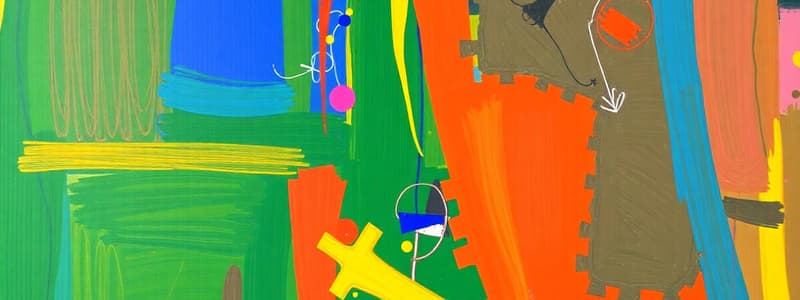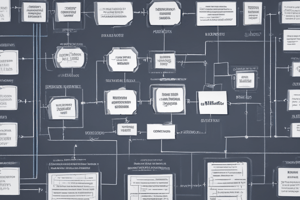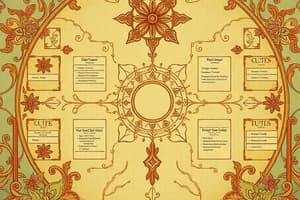Podcast
Questions and Answers
In use case diagrams, which type of relationship indicates that a child use case must be completed to fulfill a parent use case?
In use case diagrams, which type of relationship indicates that a child use case must be completed to fulfill a parent use case?
- Generalization
- Association
- Inclusion (correct)
- Extension
What is the primary purpose of using the 'include' relationship in use case modeling?
What is the primary purpose of using the 'include' relationship in use case modeling?
- To define inheritance between use cases, where the child inherits from the parent.
- To simplify complex use cases by extracting common behaviors. (correct)
- To establish a direct link between actors and use cases.
- To represent optional or alternative behaviors in a system.
If a library member has a fine to pay and can choose between using PayPal or a credit/debit card, which use case relationship would best model this scenario?
If a library member has a fine to pay and can choose between using PayPal or a credit/debit card, which use case relationship would best model this scenario?
- Generalization
- Extension (correct)
- Inclusion
- Association
In use case generalization, what is the primary characteristic of the child use case in relation to its parent?
In use case generalization, what is the primary characteristic of the child use case in relation to its parent?
Which of the following is true regarding generalization in use case diagrams?
Which of the following is true regarding generalization in use case diagrams?
Which of the following is the MOST accurate description of the primary goal of a Use Case diagram?
Which of the following is the MOST accurate description of the primary goal of a Use Case diagram?
In a Use Case diagram, what does the 'system boundary' represent?
In a Use Case diagram, what does the 'system boundary' represent?
Which of the following BEST describes how to identify potential actors in a Use Case diagram?
Which of the following BEST describes how to identify potential actors in a Use Case diagram?
A library system allows patrons to 'Borrow a Book', 'Return a Book', and 'Renew a Book'. What would be the MOST appropriate way to name these functions in a Use Case diagram?
A library system allows patrons to 'Borrow a Book', 'Return a Book', and 'Renew a Book'. What would be the MOST appropriate way to name these functions in a Use Case diagram?
In the context of Use Case diagrams, which of the following is the MOST accurate description of an 'actor'?
In the context of Use Case diagrams, which of the following is the MOST accurate description of an 'actor'?
A customer using a 'CoffeeApp' interacts with the system to place an order. Which of the following represents a valid use case derived from this interaction?
A customer using a 'CoffeeApp' interacts with the system to place an order. Which of the following represents a valid use case derived from this interaction?
When creating a Use Case diagram for an online shopping system, which of the following would be MOST suitable to represent as an actor?
When creating a Use Case diagram for an online shopping system, which of the following would be MOST suitable to represent as an actor?
What is the significance of relationships between actors and use cases in a Use Case diagram?
What is the significance of relationships between actors and use cases in a Use Case diagram?
Which of the following best describes the primary focus of a use case diagram?
Which of the following best describes the primary focus of a use case diagram?
In use case specifications, what is primarily captured within the scenarios (flow of events)?
In use case specifications, what is primarily captured within the scenarios (flow of events)?
In the coffee app example, what is the primary function of the 'validate order' use case?
In the coffee app example, what is the primary function of the 'validate order' use case?
Which of the following best describes the relationship between the 'Log In' use case and 'Verify Password' use case?
Which of the following best describes the relationship between the 'Log In' use case and 'Verify Password' use case?
When constructing a use case diagram, from whose perspective should it primarily be structured and organized?
When constructing a use case diagram, from whose perspective should it primarily be structured and organized?
What type of relationship should be used to model the interaction between 'Pay by Credit Card' and 'Pay by PayPal' if both are alternative payment methods for a 'Checkout' use case?
What type of relationship should be used to model the interaction between 'Pay by Credit Card' and 'Pay by PayPal' if both are alternative payment methods for a 'Checkout' use case?
What is the primary purpose of a use case specification?
What is the primary purpose of a use case specification?
What does it mean when a use case is said to be 'meaningful on its own' in the context of an 'extend' relationship?
What does it mean when a use case is said to be 'meaningful on its own' in the context of an 'extend' relationship?
Which element of a use case specification provides a brief explanation of the role and intention of a use case?
Which element of a use case specification provides a brief explanation of the role and intention of a use case?
What is the significance of using a dotted line with an arrowhead pointing to the base use case from the child use case in a use case diagram?
What is the significance of using a dotted line with an arrowhead pointing to the base use case from the child use case in a use case diagram?
What should be the initial approach when structuring a use case diagram?
What should be the initial approach when structuring a use case diagram?
In use case diagrams, where are actors typically positioned in relation to the system boundary?
In use case diagrams, where are actors typically positioned in relation to the system boundary?
How should the level of detail in a use case diagram evolve during its creation?
How should the level of detail in a use case diagram evolve during its creation?
Besides people, what other elements can function as actors in a use case diagram?
Besides people, what other elements can function as actors in a use case diagram?
Consider a scenario where the coffee app needs to handle a situation when the selected store is closed. Which use case relationship would be most appropriate to model the 'Display Store Closed' functionality?
Consider a scenario where the coffee app needs to handle a situation when the selected store is closed. Which use case relationship would be most appropriate to model the 'Display Store Closed' functionality?
When should the include relationship be used in use case modeling?
When should the include relationship be used in use case modeling?
Which element of a use case specification defines the state of the system after the use case has successfully completed?
Which element of a use case specification defines the state of the system after the use case has successfully completed?
In use case modeling, what do 'actors' primarily represent?
In use case modeling, what do 'actors' primarily represent?
What is the primary purpose of documenting 'alternate flows' in a use case specification?
What is the primary purpose of documenting 'alternate flows' in a use case specification?
Which aspect of a use case specification captures requirements not directly addressed in the use-case model but crucial for the design and implementation?
Which aspect of a use case specification captures requirements not directly addressed in the use-case model but crucial for the design and implementation?
Within the context of use case specifications, what is the role of 'pre-conditions'?
Within the context of use case specifications, what is the role of 'pre-conditions'?
What is the main goal of creating a use case diagram for a complex system process, like 'deposit and transfer money' in a banking system?
What is the main goal of creating a use case diagram for a complex system process, like 'deposit and transfer money' in a banking system?
In a use case scenario for an online shopping system, a customer attempting to purchase an item must be logged in. Which element of the use case specification would this requirement fall under?
In a use case scenario for an online shopping system, a customer attempting to purchase an item must be logged in. Which element of the use case specification would this requirement fall under?
Consider a use case for withdrawing money from an ATM. After the transaction, the ATM must update the account balance and dispense the cash. Which part of the use case specification would describe the updating of the account balance?
Consider a use case for withdrawing money from an ATM. After the transaction, the ATM must update the account balance and dispense the cash. Which part of the use case specification would describe the updating of the account balance?
Flashcards
Use Case Diagram
Use Case Diagram
A visual representation of interactions between actors and a system, used to understand the system's functional requirements.
Actors (in UML)
Actors (in UML)
Internal or external entities (users, systems) that interact with the system.
Use Cases
Use Cases
Actions or functions the system performs to meet goals (functional requirements).
Relationships (in UML)
Relationships (in UML)
Signup and view all the flashcards
System Boundary
System Boundary
Signup and view all the flashcards
Identifying Actors
Identifying Actors
Signup and view all the flashcards
Finding Use Cases
Finding Use Cases
Signup and view all the flashcards
Naming Use Cases
Naming Use Cases
Signup and view all the flashcards
Coffee App: Start
Coffee App: Start
Signup and view all the flashcards
Select Store
Select Store
Signup and view all the flashcards
Enter Coffee Choice
Enter Coffee Choice
Signup and view all the flashcards
Anything Else?
Anything Else?
Signup and view all the flashcards
Select Checkout
Select Checkout
Signup and view all the flashcards
Request Payment
Request Payment
Signup and view all the flashcards
Enter Card Number
Enter Card Number
Signup and view all the flashcards
Order Confirmation
Order Confirmation
Signup and view all the flashcards
Include Relationship
Include Relationship
Signup and view all the flashcards
Generalization Relationship
Generalization Relationship
Signup and view all the flashcards
Payment Option Use Case
Payment Option Use Case
Signup and view all the flashcards
Simplifying Use Cases
Simplifying Use Cases
Signup and view all the flashcards
Common Event Flows
Common Event Flows
Signup and view all the flashcards
What is an actor?
What is an actor?
Signup and view all the flashcards
What is a scenario?
What is a scenario?
Signup and view all the flashcards
What is a Use Case Specification?
What is a Use Case Specification?
Signup and view all the flashcards
What is Flow of Events?
What is Flow of Events?
Signup and view all the flashcards
The Purpose of Use Case Diagrams
The Purpose of Use Case Diagrams
Signup and view all the flashcards
The Focus of Use Case Diagrams
The Focus of Use Case Diagrams
Signup and view all the flashcards
How to Approach Use Case Diagrams
How to Approach Use Case Diagrams
Signup and view all the flashcards
How should you structure a Use Case Diagram?
How should you structure a Use Case Diagram?
Signup and view all the flashcards
Actors (Use Case)
Actors (Use Case)
Signup and view all the flashcards
Use Case Preconditions
Use Case Preconditions
Signup and view all the flashcards
Flow of Events (Use Case)
Flow of Events (Use Case)
Signup and view all the flashcards
Basic Flow (Use Case)
Basic Flow (Use Case)
Signup and view all the flashcards
Alternate Flows (Use Case)
Alternate Flows (Use Case)
Signup and view all the flashcards
Use Case Post-conditions
Use Case Post-conditions
Signup and view all the flashcards
Special Requirements (Use Case)
Special Requirements (Use Case)
Signup and view all the flashcards
Key Scenarios (Use Case)
Key Scenarios (Use Case)
Signup and view all the flashcards
Study Notes
- These notes are on software modeling, specifically use case diagrams. UML (Unified Modeling Language) includes use case diagrams, but it is not necessary to use every part of UML.
What is a Use Case Diagram?
- Provides a visual representation of interactions between actors (users or external systems) and a system.
- Defines, communicates, and helps to understand the functional requirements of a system.
Goal of Use Case Diagrams
- Helps users (developers, designers, customers) to understand system functionality from a user's point of view.
- Useful for gathering and documenting functional requirements.
- Facilitates communication and discussion of system functionality with various stakeholders.
- Drives implementation and generates test cases based on specified requirements.
Use Case Elements
- Actors: Internal or external users that interact with the system (e.g., human, organization, machine, or other external systems).
- Use Cases: Actions or functions that the system needs to perform to meet its goals (FR - Functional Requirements).
- Relationships: Connections/interactions between users and use cases (dependencies, generalizations, and associations).
- System Boundary: A box around the use cases that separates them (internal) from the actors (external).
- Functional requirements guide the identification of actors, use cases, and relationships
How to Identify Actors
- Consider the defined roles played by people who interact with the system and other systems.
- Determine the roles users play.
- Identify who provides information to the system (inputs) and who receives information from the system (outputs).
- Actors can be principal users or secondary entities like external hardware or other systems.
- Actors interact with a use case that defines a system function.
- Name actors with nouns.
- Note: Actors are roles played by people and one person perform multiple roles and maybe other systems, and can be have names.
How to Find Use Cases
- Begin with a list of actors.
- Identify their needs from the system.
- Consider their interactions.
- Use cases are are typically named with a verb + noun
- Each Actor must be linked to a use case, some use cases don't need to be linked to actors
Relationship Types for Use Cases
- <
> usage: Indicates optional or alternative behaviors on a normal behavior and it is optional. - <
> usage: Shows must be included and complementary functionalities, logical dependencies; used to avoid repetition, when you repeat yourself in more separate use cases. - <
> usage: Describes variations on normal behavior or represents inheritance relations.
<> Relation
- Models optional system behavior and conditions.
- The extended use case can add behavior to a base case, but can be meaningful and independent on its own.
- In diagrams, it's a dotted line with the arrowhead pointing to the base use case from the child use case.
Relation: <>
- The child use case must be done to complete the parent use case.
- Used when common event flows are put into a use case, which is then included into the behavior of the base use case to avoid repetitive descriptions.
- Simplifies large use cases by splitting them and also represents is a directed arrow having a dotted. Line with the arrowhead pointing to the child use case from the parent use case.
Relation: Generalization
- The parent–child relationship between use cases.
- The child use case inherits behavior and meaning from the parent use case.
- The child may also override parent behavior.
- Depicted with a directed arrow with triangle arrowhead.
Tips for Use Case Diagrams
- Structure and organize the diagram from the perspective of the actors.
- Keep use cases simple and at a high level initially, then refine.
- Focus on the functionality of the system.
Use Case Specification
- Details the steps and interactions required to implement a specific use case, describing the interactions between users and the system with graphical models and structured text.
- Composed of actors and scenarios/flow of events, it captures the functional requirements.
- Includes name of use case, description, actors, preconditions, flow of events, key scenarios, special requirements, post-conditions, and alternate flows each representing a different scenario.
Studying That Suits You
Use AI to generate personalized quizzes and flashcards to suit your learning preferences.




